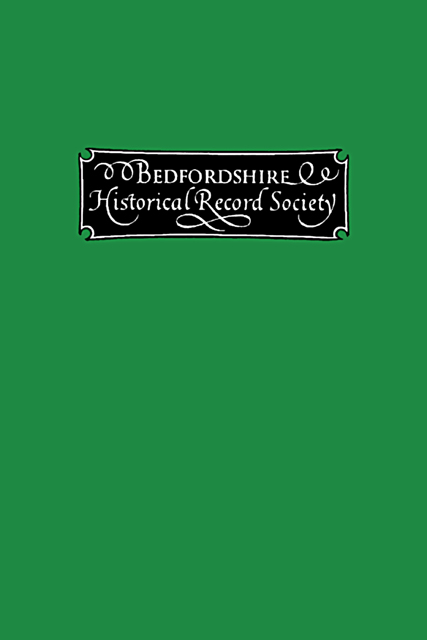Book contents
- Frontmatter
- Contents
- The Meeting-place of Wixamtree Hundred
- Two Cranfield Manors
- The Register of the Fraternity of St. John the Baptist, Dunstable, 1506-8, 1522-41
- Newnham Priory : a Bedford Rental, 1506-7
- Newnham Priory : Rental of Manor at Biddenham, 1505-6
- The Papers of Richard Taylor of Clapham, c. 1579-1641
- John Crook, 1617-1699 : a Bedfordshire Quaker
- A Bedfordshire Wage Assessment of 1684
- A Luton Baptist Minute Book, 1707-1806
- Miscellaneous Endmatter
- Index of Persons and Places
- Index of Subjects
- Miscellaneous Endmatter
- Maps
The Papers of Richard Taylor of Clapham, c. 1579-1641
Published online by Cambridge University Press: 18 July 2023
- Frontmatter
- Contents
- The Meeting-place of Wixamtree Hundred
- Two Cranfield Manors
- The Register of the Fraternity of St. John the Baptist, Dunstable, 1506-8, 1522-41
- Newnham Priory : a Bedford Rental, 1506-7
- Newnham Priory : Rental of Manor at Biddenham, 1505-6
- The Papers of Richard Taylor of Clapham, c. 1579-1641
- John Crook, 1617-1699 : a Bedfordshire Quaker
- A Bedfordshire Wage Assessment of 1684
- A Luton Baptist Minute Book, 1707-1806
- Miscellaneous Endmatter
- Index of Persons and Places
- Index of Subjects
- Miscellaneous Endmatter
- Maps
Summary
Among the muniments of the Corporation of Bedford are preserved some papers of Richard Taylor of Clapham, burgess, justice of the peace, and deputy recorder of Bedford, and member of parliament in the reign of Charles I. It may be convenient to give some account of Taylor’s family and career as a preliminary to these.
THE TAYLOR FAMILY
The Visitation of 1634 gives Lidlington as the place of origin of the family, and its founder as Thomas, Richard’s grandfather, who is credited with partly rebuilding Lidlington church. Thomas Julyan alias Taylor, yeoman, bought Grymsbury in Bolnhurst in 1579 and left it to his second son, Thomas. Thomas left directions that Grymsbury should be assigned to his son Richard at the age of 21, and this was done in 1600. Richard thus seems to have been born in 1579. It was also in 1600 that Richard Taylor was admitted to Lincoln’s Inn. On 12 August 1613 he married Elizabeth, daughter of William and Ursula Boteler of Biddenham. He was one of the borough members in the parliaments of 1620, 1623, 1625 and 1628; during the whole of which time he was deputy recorder for Bedford.7 He is named in two Bedford commissions of the peace, one undated, the other 15 Charles I, besides being also in the commission for the county.
In 1626 Charles I, having dismissed his second parliament before subsidies had been passed, tried to obtain money by demands for free gifts and loans addressed to his principal subjects, and “our trustie and welbeloved Mr. Taylor of the towne of Bedford” received a demand for £50 dated 14 August 1626. He seems also to have taken the lead at a general meeting on 17 August called to raise more money for the king; of his speech for this meeting notes remain, and there is also a vivid description of the gathering among his papers. It is clear that among these growing signs of storm his sympathies were already Royalist.
Meanwhile his own position was becoming more assured. In 1624 he had received a grant of arms (ermine, on a chief dancettee sable, a ducal coronet or, between two escallops argent).
- Type
- Chapter
- Information
- The Publications of the Bedfordshire Historical Record Society , pp. 104 - 109Publisher: Boydell & BrewerFirst published in: 2023



